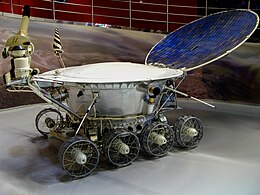Lunokhod 1

Lunokhod 1 rover
|
|
| Mission type | Lunar rover |
|---|---|
| COSPAR ID | 1970-095A |
| Website | Lunar and Planetary Department Moscow University Lunokhod 1 page |
| Spacecraft properties | |
| Launch mass | 5,600 kilograms (12,300 lb) |
| Dry mass | 756 kilograms (1,667 lb) (rover only) |
| Power | 180 watts |
| Start of mission | |
| Launch date | November 10, 1970 |
| Rocket | Proton-K/D |
| Launch site | Baikonur 81/23 |
| End of mission | |
| Last contact | September 14, 1971 |
| Lunar rover | |
| Spacecraft component | Rover |
| Landing date | November 17, 1970, 03:47:00 UTC |
| Landing site | 38°14′16″N 35°00′06″W / 38.2378°N 35.0017°W |
Lunokhod 1 (Луноход, moon walker in Russian; Аппарат 8ЕЛ № 203, vehicle 8ЕЛ№203) was the first of two unmanned lunar rovers landed on the Moon by the Soviet Union as part of its Lunokhod program. The Luna 17 spacecraft carried Lunokhod 1 to the Moon in 1970. Lunokhod 1 was the first remote-controlled robot "rover" to freely move across the surface of an astronomical object beyond the Earth. Lunokhod 0 (No.201), the previous and first attempt to do so, launched in February 1969 but failed to reach orbit.
Lunokhod 1 was a lunar vehicle formed of a tub-like compartment with a large convex lid on eight independently powered wheels. Its length was 2.3 metres (7 ft 7 in). Lunokhod was equipped with a cone-shaped antenna, a highly directional helical antenna, four television cameras, and special extendable devices to test the lunar soil for soil density and mechanical properties. An X-ray spectrometer, an X-ray telescope, cosmic ray detectors, and a laser device were also included. The vehicle was powered by batteries which were recharged during the lunar day by a solar cell array mounted on the underside of the lid. To be able to work in vacuum a special fluoride based lubricant was used for the mechanical parts and the electric motors (one in each wheel hub) were enclosed in pressurized containers. During the lunar nights, the lid was closed and a polonium-210 radioisotope heater unit kept the internal components at operating temperature. Lunokhod was intended to operate through three lunar days (approximately 3 Earth months) but actually operated for eleven lunar days.
...
Wikipedia
